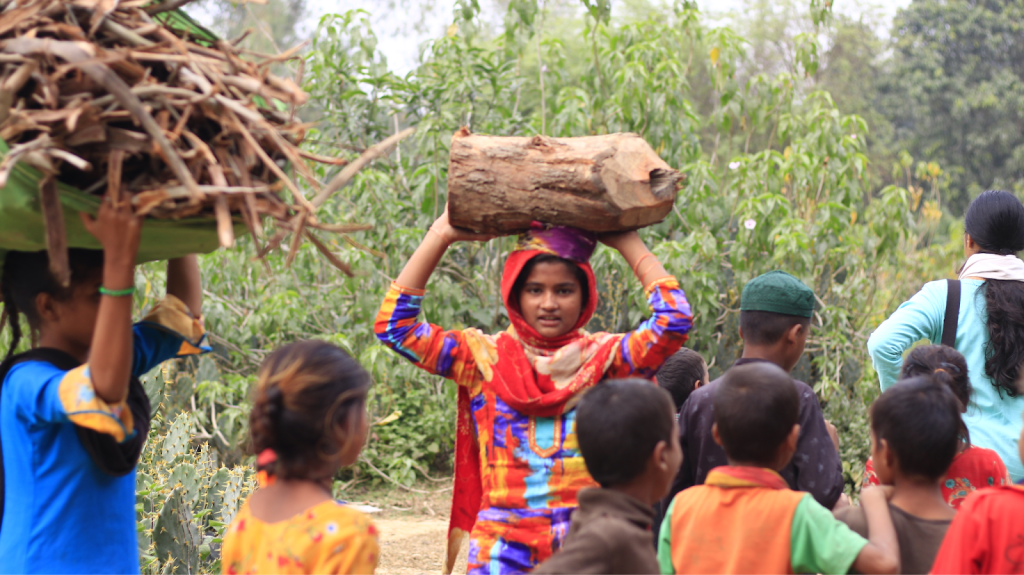The social tags that one carries are often building blocks of a strong sense of identity around which well being gets curated. For handloom weavers who have been practising their skills for many generations, the way consumers would value their work and acknowledge the effort, time and intent behind retaining such a beautiful tradition plays a pivotal role in their personal and professional growth.

A few miles away from a town that is famously recognized for donkeys, Barabanki, one can glide to the rhythmic tune emanating from the hand looms along the lanes with kacha and pakka houses spread around the villages. With a haveli which is more than 400 years old in the vicinity, that has recently been attracting some footfall from the movie industry, it is of no surprise that a huge crowd of villagers, irrespective of their age, gather around brimming with curiosity. But, if one doesn’t fail to wonder if the women weren’t equally intrigued, the social backdrop of Saidanpur village pans out on different canvases. One of these portrays young girls collecting and carrying firewood everyday to cook food as they don’t have a gas based stove and another portrays them trying to make a living out of helping the family looms or stitching along with taking care of household chores. Amidst these, there are also women like Noori, currently a trainer under Digital Empowerment Foundation (DEF), who has rebelled to step out on her own to be different and enjoys the fruits of her struggle as she proudly moves around the village freely on her own scooter. And there are also women like Seema who move within the circles of the village trying to help DEF to bridge the gaps and encourage girls to grow further.
 A young girl from Saidanpur busy with her daily chores.
A young girl from Saidanpur busy with her daily chores.
Unlike these social adaptations that are en-route with a slow pace, the trajectory of changes in the 300 years old tradition of hand loom weaving which was said to be introduced by Sayyad, from whom the village derives its name, have been quite steep. Especially post Covid-19, the village which boasted about 200 weaving families is struggling to name at least 25 families that are continuing this under the tag of helplessness. Currently, the process of weaving that involves dyeing of the threads, setting the threads of different colours according to the pattern, joining respective ends of threads, setting it on the loom and weaving accordingly, has been distributed throughout the village in a fragmented way owing to either the long pre-processing methods or the reins of control of workflow taken over by master-weavers. Consequently, a weaver evaluates himself as a mere labourer rather than an artisan as he is no longer involved even in the choice of threads or designs and engagement with the market.
 Warping tool found in every weaver’s house.
Warping tool found in every weaver’s house.
One such weaver is Shiraz who is the only one in his paternal family continuing this profession for 20 years. In an attempt to make a better living, he has set up a loom at his humble abode along with a small shop, which he and his family work on everyday, all year around, starting from 5 am in the morning. Although he has taught his 16 year old daughter, Arsula, to weave so that her mind is occupied, he avoids passing it on to his son and encourages him to find a different occupation to make ends meet. Arsula on the other hand takes up the role of a weaver early in the morning, a dedicated student during the day, a homemaker in the evening and an artist in her free time. Her half an hour walk to school is nowhere reflected in her busy routine. Her diagrams in her biology books starkly displayed her interest in the field of medicine and it leaves no doubt about her passion to dream of identifying herself as a doctor one day. Unfortunately, she has come to accept that the expenses incurred to study medicine is not something her family can bear and expresses her hesitation to step out of the village on her own to pursue her further studies. Hope lies in seeing either Shiraz moving forward to venture into the business of weaving, overcoming the odds or his daughter taking bolder steps to find her way into the path of her ambition to set an example for others to follow.
Time and again it is proven that the recognition of relevance of values is what keeps the traditions alive and in this case, economic viability seems to be the foundation of it. There is an unnoticeable fact in the village that the thought of a new step is always accompanied by another thought, “ yaha bahuth dikhath hoti hai ”, which translates to “there are many obstacles here”. While Saidanpur tries to find opportunities to change in its state of flux, the inner debate about the impact of the choice of end users on their efforts is an itch to carry around.










